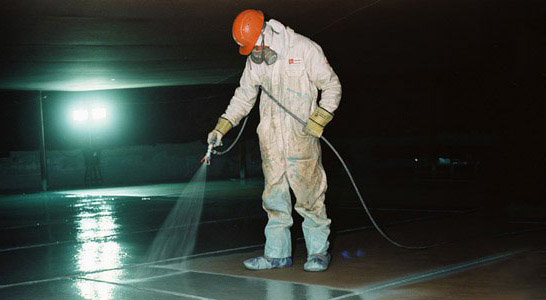How FRP Linings Are Applied To Steel Tanks
There are two methods by which FRP tank lining systems can be applied. There is hand lay-up and spray-up methods to install the FRP lining. Before either type of coating can be applied sand blasting has to be done to remove any debris or corrosion. This provides a clean and rough surface for the primer to be applied on. Adhesion of either system is dependent upon having that rough and primed surface.
Spray-Up Method
Glass-chopper guns are used to apply the spray-up FRP linings. The glass-chopper gun mixes to glass roving and resin components at the time of being sprayed. Dual head glass-chopper guns allow very rapid rates of depositing the coating. The average thickness of the resin at the tank bottoms are typically a quarter inch when the spray-up method is used.
Hand Lay-Up Method
While the spray-up method is quicker the hand lay-up method is the preferred method of consistency. This method produces a more consistent, and uniform layer of coating. The quality of the hand lay-up method does take more time, requires more labor, and longer time for the resin gel to dry. While being more labor intensive this method does take less skill to apply.
To apply the lining using the hand lay-up method a heavy layer of resin is applied with brushes, rollers, or it is sprayed on. The next step is applying the glass mat to the wet resin and ensuring it is fully saturated with the resin to make sure adhesion is strong. Lastly a seal coat is applied on top of the resin and glass mat. This is only done after the resin saturated material has gelled.
FRP Lining Application Approach
Quality FRP tank coatings rely on how the lining is applied. The standardized approach for applying an FRP hand lay-up tank coating has 5 distinct phases that must be followed.
Prepare The Surface
Organic contaminants build up in steel storage tanks and must be removed. Following this the internal surfaces must be blasted with abrasive materials to prepare the inside of the tank for the primer and resin.
Applying The Primer
Immediately after the blasting is complete the dry film polyamide-cured epoxy primer is applied at a thickness of 1 to 3 mils. It is applied to prevent any contamination of the bare metal surface and to “hold” the tank in condition for the resin phase. Sharp angles in the tank, especially those at the bottom are filled in with a putty type material which includes the fibers and fillers. This putty material should of the same compound as the resin you will use for the tank to ensure proper adhesion. Any deeply pitted tanks should be resurfaced with the same fill material to create a smooth bottom.
Resin Application & Fiberglass Reinforcement
Resin is applied in a heavy layer by brush, sprayer, or roller. While the resin is still wet the fiberglass mat is laid into it and full saturation should be ensured.
The dry film thickness is decided by the full extent of the carrions on the bottom of the tank, and the source of the corrosion. Internal corrosion is controlled by a film thickness of 60 to 80 mils to help protect the bottom of the tank from internal corrosion. The exterior of the tank requires a thicker coating and will end up needing a film layer starting at 80 miles and going up to 120 mils. This helps protect the tank from the external corrosive forces.
Final Coating
A finish coat that is a resin rich layer of polyester resin is applied as the seal coat. This process helps prevent capillary action which causes wicking along the partially exposed glass fibers that stick out of the resin. Paraffin wax aids in the curing process and is added to the base resin that helps produce this seal coat.
Final Inspection
Before the tank is passed for use again an inspection should be carried out to ensure that the FRP lining has been successfully installed. A magnetic dry film tester is used to check the thickness of the dry film. Before the seal coat is applied the thickness of the bottom of the tank should be inspected with a high voltage holiday detector.
Steel Tank FRP Linings In Phoenix
If you have steel storage tanks in the Phoenix area that need to have new fiberglass tank coatings installed All Kote Lining is highly skilled, has the right techniques and is dedicated to getting the job done right quickly and the first time. Give us a call at 480-966-4446 and we can help you will your tank coating needs.

